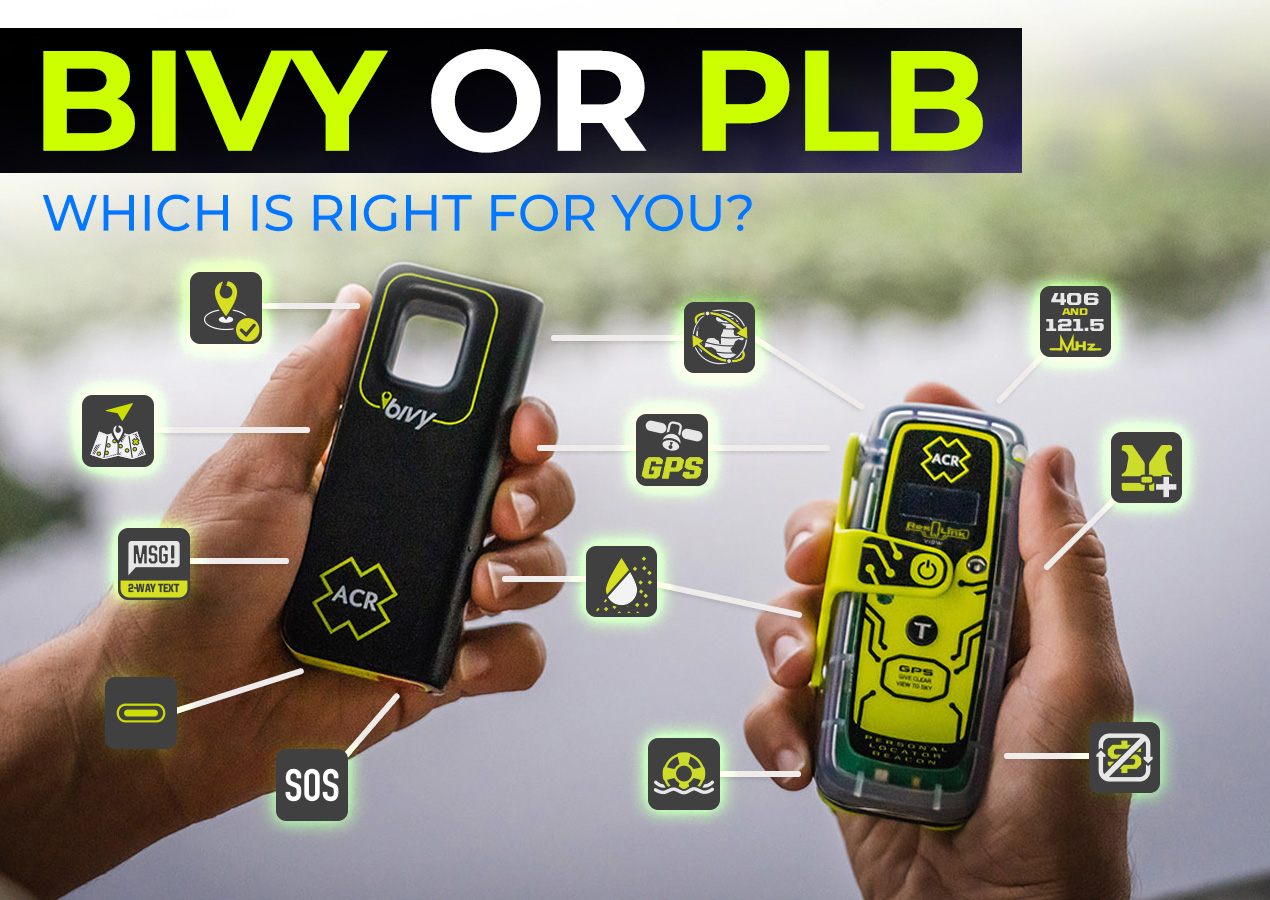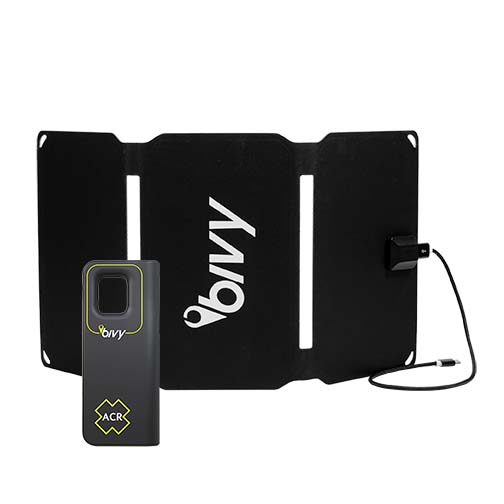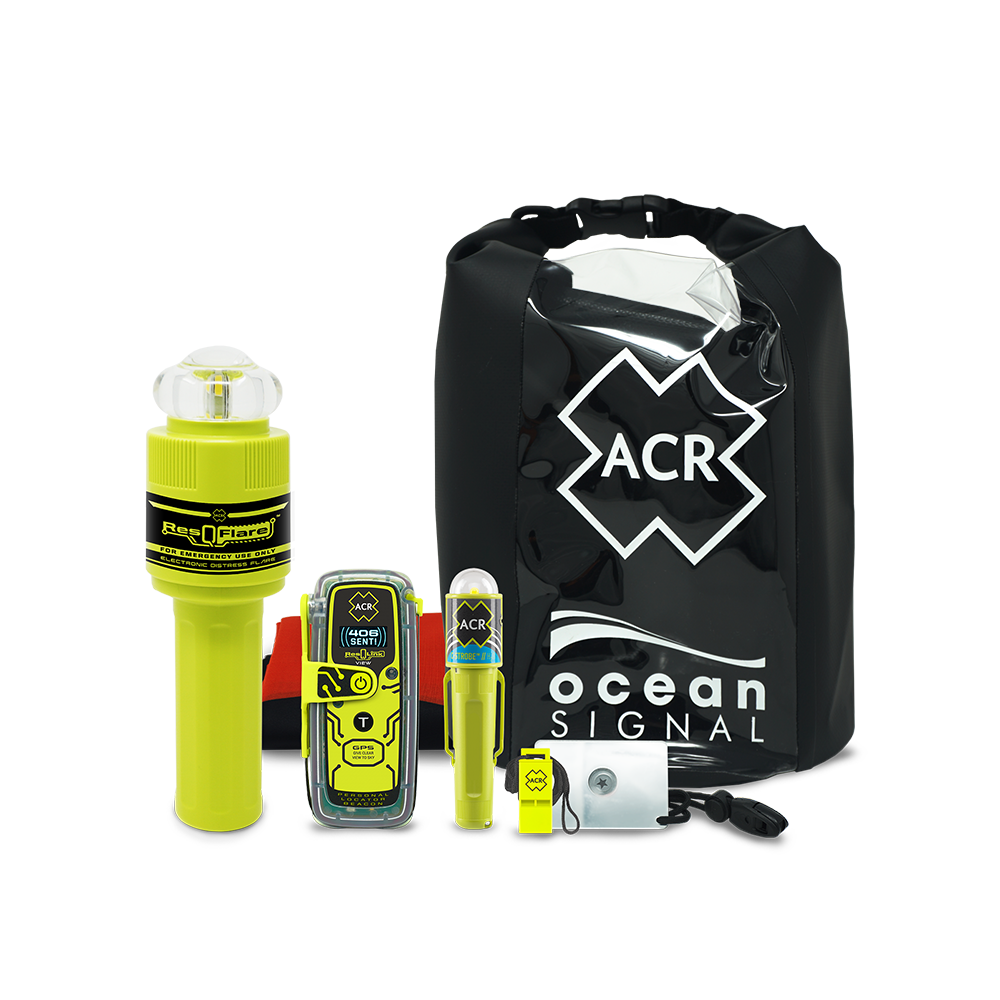 PLB Vs Bivy
PLB Vs Bivy
Personal Locator Beacons (PLB) Versus Satellite Communication Devices
Posted on June 14, 2023
There’s nothing quite like the exhilaration of exploring the great outdoors. Veering off the beaten path on your trail run, boating in the most serene areas, and simply enjoying the beauty of nature are some of the best experiences we can have.
As an outdoor enthusiast, you know using a smartphone for communication while you’re on your adventure isn’t enough. You’ll often travel to remote areas where there isn’t any cell signal, leaving you with no way to communicate with others.
Luckily, technology has advanced and we can now communicate with anyone in the world from any location, thanks to satellite networks.
The advent of satellite communication now means that you never have to be cut off from loved ones, adventure buddies, or even emergency services.
Personal Locator Beacon or PLB Versus a Satellite Communicator
In the realm of outdoor safety, two beacon technologies vie for attention: Personal Locator Beacons (PLBs) and Bivy’s satellite communicators. PLBs, tethered to Cospas-Sarsat Satellites, epitomize last-resort emergency tools, ensuring global rescue coordination by continuously sharing your location. In contrast, Satellite Communicator like the Bivy Stick, harnessing Iridium Satellites, and merge SOS functionality with robust outdoor connectivity. Its app empowers adventurers with messaging, real-time tracking, weather updates, and check-in features. While PLBs offer subscription-free service, Bivy’s flexibility accommodates diverse communication needs through customizable plans. During emergencies, PLBs excel in broadcasting positions with enduring battery life and signaling capabilities. Conversely, Bivy facilitates two-way communication, enhancing rescue coordination with messaging options. Are you the prudent planner preferring essential emergency aid? Opt for the dependable PLB. Or do you seek comprehensive outdoor connectivity? Embrace Bivy’s multifunctional features for an enriched wilderness experience. Choose wisely, adventure awaits.
What Is a Satellite Communication Device?
Also referred to as a satellite messenger or a satellite communicator, a satellite communication device is a portable technology that is designed to allow seamless two-way communication, particularly in areas where there is no other reliable communication structure, such as cellular coverage. A satellite communication device is a vital tool for adventurers, providing a lifeline to the outside world in remote and challenging environments. Harnessing the power of Iridium satellite technology, these devices offer a range of functionalities, from emergency SOS signaling to two-way messaging and real-time tracking. Whether you’re hiking through dense forests, navigating treacherous terrain, or embarking on an epic expedition, a satellite communication device ensures you stay connected and safe, even when traditional means of communication fail. With global coverage and robust reliability, these devices empower outdoor enthusiasts to explore with confidence, knowing help is just a button press away.
How are they different from cell phones?
While a cell phone can provide convenient and feature-rich communication in areas with adequate cellular service, satellite messengers excel at providing communication capabilities in remote, off-grid, or emergency situations when coverage doesn’t exist.
The key differences between a cell phone and a two-way satellite communicator are:
- Communication technology: Cell phones use a terrestrial communication infrastructure such as towers and networks to communicate. On the other hand, satellite communicators use satellites to communicate.
- Coverage: Cell phones use coverage provided by cellular networks, which means coverage is limited to where there are towers and networks available. A satellite communicator offers global coverage in even the most remote regions.
- Functionality: Phones offer many features other than just communication, whereas satellite messengers are typically designed only for the purpose of communication off grid, tracking, and direct SOS communications.
- Battery life: Satellite messengers usually have a long battery life compared to a regular phone, making them ideal for extended use in areas without access to electricity. The SOS function can also work independent of a cell phone providing valuable backup should the phone battery die.
- Price: Some satellite communication devices can be quite expensive compared to the price of an average smartphone. However, you will soon learn why they’re a worthwhile expense.
- Antenna strength: The antenna’s connection to a satellite isn’t as strong as other devices, such as a Bivy Stick. Trees can impact the connection and slow it down.
- Foliage: The heavier the foliage, the slower the service for cell phones.
- Logistical limitations: Emergency response is locally administered, so cellphone based Satellite SOS is only available in approved areas. Satellite Communicators and Personal Locators Beacons have Global SOS.
Who should use a satellite device for communication?
No matter where you are in the world, you can rely on satellite communication to allow you to send and receive messages and share your GPS location. However, a satellite communicator is typically designed for:
- Outdoor enthusiasts: Hikers, campers, trail runners, mountaineers, and any other adventurers who want to explore remote areas.
- The maritime industry: Ships, boats, and other vessels that operate in remote waters can use these devices to stay connected to on-land personnel, access weather reports, and for navigation.
- Aviation: Aircraft, especially those that operate in vast stretches of remote regions, can use satellite communication systems for air traffic control, weather forecasting, in-flight connectivity, and distress communication.
- Search and rescue: During natural disasters or search and rescue operations, satellite communicators provide responders and relief organizations with a way to communicate when cell phone infrastructure has been damaged or destroyed.
Satellite devices are also usually used by military and defense organizations, telecommunications service providers, and humanitarian organizations.
What Are the Best Satellite Communication Devices?
Now that you know more about this advanced outdoor communication device, let’s explore some of the best products on the market that you can purchase ahead of your next big adventure.
The ACR Bivy Stick
A Bivy Stick is our brand of satellite messengers designed for seamless communication, GPS location sharing, and transmitting a distress signal when an emergency situation arises.
Our Bivy Stock uses the Iridium satellite network specifically. These are private networks of satellite systems that are designed specifically for communication.
The Bivy Stick provides you with a dedicated phone number and email address which allows incoming messages. This means that your friends and family can reach you at any time without you initiating contact, providing peace of mind for both you and your loved ones.
The Bivy App not only allows you to track all of your adventures, including pace and altitude, but it also has more than 50,000 pre-loaded adventures ready to be explored.
A Bivy Stick can be used by outdoor adventurers, mariners, and aviators.
Perhaps the most vital feature of the ACR Bivy Stick is that it can be used in emergency situations to communicate with rescue services, providing them with your GPS location and other important information so that they can find you.
Our Bivy Stick can connect to a smartphone using Bluetooth, or it can be used as a standalone device. You can use either the device or your phone’s full qwerty keyboard to send and receive satellite text messages.
Other Bivy Stick features include:
- A 120-hour battery life.
- Satellite SOS monitoring via Global Rescue.
- Satellite weather forecasts.
- Download offline maps.
- Send and receive messages from other Bivy Stick users.
- Unlimited free check-in messages.
- A small, lightweight, and rugged design.
- Location tracking and sharing.
- Bluetooth connectivity.
- GPS tracking.
- Customized messages.
- Zero activation fees.
- Off-grid group messaging.
Additionally, you can purchase our new Bivy Stick kits that include solar panels so that you can conveniently extend the battery life of the device while off-grid.
ACR personal locator beacons (PLBs)
A personal locator beacon (PLB) is another communication device that uses satellite technology to operate.
These devices are specially designed with emergency situations in mind. A personal locator beacon can be used to send an emergency signal to nearby search and rescue operators, letting them know that you are in danger.
We have a variety of PLBs to choose from, including some specifically designed for marine activities and aviation.
Our range of PLBs uses the Cospas Sarsat satellite system to send your emergency signal to the nearest rescue team from your location.
The signal that the device sends includes your location data, accurate to 100 meters, to the rescue personnel, and—thanks to the built-in return link service (RLS)—you’ll be notified the minute your signal has been received, providing the comfort of knowing help is on its way.
This simple satellite communication device could be the thing that saves your life.
It’s worth noting that you must register your PLB with your local authority, which is required by law in many countries. Registration is typically free and ensures that search and rescue services can access the emergency information associated with your PLB, such as your emergency contacts. In some instances, rescue personnel can get vital information by getting in touch with your listed emergency contacts.
Other key features of most ACR personal locator beacons include:
- A dedicated SOS button to send distress signals.
- Smartphone connectivity with near-field communication (NFC).
- Return link service (RLS).
- Seamless installation into most life jackets.
- Over 24 hours of battery life.
How to choose the right device for your outdoor activities
We stock a wide range of two-way satellite messaging devices for you to choose from. However, we realize that you might not know where to start when shopping for your device.
Here are the top factors and features you should consider when purchasing a satellite communication device.
Battery life
If you encounter an emergency, it might take some time for rescue teams to locate and reach you. For this reason, you want your device to include decent battery life so that it lasts long enough for search and rescue to find you.
Extended battery life also mean you can continue your adventure for as long as you’d like.
The ACR Bivy Stick, for example, boasts over 120 hours of battery life, making it the perfect device for longer adventures.
A phone app
You want the device you purchase to come with a smartphone app that you can use to manage and maintain the device. An added bonus would be activity tracking features like those in our Bivy App.
When it comes to managing your ACR PLB, you can use the built-in near-field communication (NFC) to connect your device with our app. Within the app, you can run self-tests to ensure the device works properly, access beacon data, and set up your emergency contacts and information.
Weather forecasts
Accessing a weather report on your Bivy Stick isn’t just a nice-to-have feature, it’s essential to your safety.
If you’re out on a boating adventure, for example, weather reports can help you steer clear of harsher weather conditions and keep you and your crew safe.
A device that offers weather forecasts can help you monitor changing conditions in real-time, meaning you can make informed decisions about your next move, whether that’s to get back to shore before a storm hits or to seek cover while you’re on your hike.
User interface
Your communication device needs to be easy to use. Not only because it’s simply a hassle to use a complicated device, but because you want the product to be easy to control in the event of an emergency.
Having to fumble around with small buttons and a tiny screen can make an emergency even more dire. You need to get help as quickly as possible.
Seamless messaging
Your device should allow you to send and receive messages effortlessly, both when you’re having fun outdoors or during an emergency.
The ACR Bivy Stick, for example, provides a superior messaging experience for all users, making it easy to communicate with anyone in the world and get help when you need it most.
A Device That Could Save Your Life
Having a satellite communication device allows you to keep in touch with family and friends—and your fellow adventurers—making it a worthwhile investment if you’re an outdoor enthusiast. However, more importantly, this device could save your life.
Whether you’re out on the water or climbing a mountain, a satellite communication device could save your life and the lives of others. By being able to communicate with emergency services through your device, you and your loved ones can rest assured that you can get help when you need it.
If you’re new to the world of Bivy Sticks and PLBs, visiting our website is an excellent place to start. You can browse our range of satellite communication devices to find one that suits your specific needs and your next outdoor activity. We’ve got your back on your next adventure, big or small.


